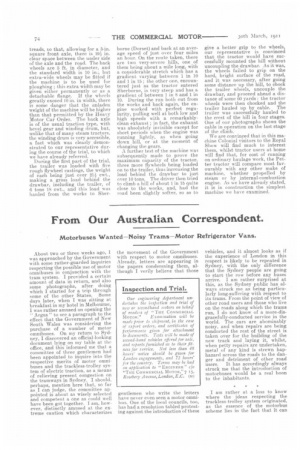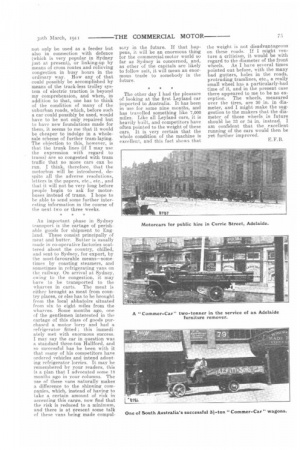From Our Australian Correspondent.
Page 6

Page 7

If you've noticed an error in this article please click here to report it so we can fix it.
Motorbuses Wanted—Noisy Trams—Motor Refrigerator Vans.
About two or three weeks ago, I was approached by the Government with some rather-guarded inquiries respecting the possible use of motor omnibuses in conjunction with the tram system. I provided a certain amount of data in return, and also some photographs, after doing which I started for a trip through some of the other States. Some days later, when I was sitting at breakfast in my hotel in Melbourne, I was rather amused on opening the " Argus " to see a paragraph to the effect that the Government of New South Wales was considering the purchase of a number of motor omnibuses. On my return to Sydney, I discovered an official-looking document lying on my table at the office, and this informed me that a committee of three gentlemen had been appointed to inquire into the respective merits of motor omnibuses and the trackless-trolley system of electric traction, as a means of relieving present congestion on the tramways in Sydney. I should, perhaps, mention here that, so far naT can i judge, the committee appointed s about. as wisely selected and competent a one as could well have been got together. I am, however, distinctly amused at the extreme caution which characterizes
the movement of the Government with respect to motor omnibuses. Already, letters are appearing in the papers condemning them, although I verily believe that those gentlemen who write the letters have never even seen a motor omnibus. One of the local councils, too, has had a resolution tabled protesting against the introduction of these vehicles, and it almost looks as if the experience of London in this respect is likely to be repeated in Sydney, with the only difference that the Sydney people are going to start the row before any buses arrive. I am rather surprised at this, as the Sydney public has always struck me as being particularly long-suffering with respect to its trams. From the point of view of other road users and those who live on the roads along which the trains run, I do not know of a more-disgracefully-conducted service in the world. The ears are abominably noisy, and when repairs are being conducted the rest of the street is taken over for the building of the new track and laying it, whilst, when petty repairs are undertaken, metal of any kind is strewn haphazard across the roads to the danger and detriment of other road users. It has accordingly always struck me that the introduction of motorbuses would be a real boon to the inhabitants.
I am rather at a loss to know where the ideas respecting the trackless-trolley system originated, as the essence of the motorbus scheme lies in the fact that it can not only be used as a feeder but also in connection with defence (which is very popular in Sydney just at present), or linking-up by means of cross routes and relieving congestion in busy hours in the ordinary way. How any of that could possibly be accomplished by means of the track-less trolley system of electric traction is beyond my comprehension, and when, in addition to that, one has to think of the condition of many of the suburban roads, which, before such a car could possibly be used, would have to be not only repaired but to have new foundations made for them, it seems to me that it would be cheaper to indulge in a wholesale scheme of further tram-laying. The objection to this, however, is that the trunk lines (if I may use the expression with regard to trams) are so congested with tram traffic that no more cars can be run. I think, therefore, that the motorbus will be introduced, despite all the adverse resolutions, letters in the papers, etc., etc., and that it will not be very long before people begin to ask for motorbuses instead of trams. I hope to be able to send some further interesting information in the course of the next two or three weeks.
An important phase in Sydney transport is the cartage of perishable goods for shipment to England. These consist principally of meat and butter. Butter is usually made in co-operative factories scattered about the country, chilled, and sent to Sydney, for export, by the most-favourable means—sometimes by coasting steamers, and sometimes in refrigerating vans on the railway. On arrival at Sydney, owing to the congestion, it may have to be transported to the wharves in carts. The meat is either brought as meat from country places, or else has to be brought from the local abbatoirs situated from six to eight miles from the wharves. Some months ago, one of the gentlemen interested in the cartage of this class of goods purchased a motor lorry and had a refrigerator fitted ; this immediately met with enormous success. I may say the car in question was a standard three-ton Hanford, and NO successful has he been with it that many of his competitors have ordered vehicles and intend adopting refrigerator lorries. It may he remembered by your readers, this is a plan that I advocated some 18 months ago in your columns. The use of these vans naturally makes a difference to the shinning companies, which, instead of having to lake a certain amount of risk in accepting this cargo, now find that the risk is reduced to a minimum, and there is at Present some talk of these vans being made compul sory in the future. If that happens, it will be an enormous thing for the commercial-motor world so far as Sydney is concerned, and, as other of the capitals are likely to follow suit, it will mean an enormous trade to somebody in the future.
The other day I had the pleasure of looking at the first Leyland car imported to Australia. It has been in use for some nine months, and has travelled something like 7,000 miles. Like all Leyland cars, it is heavily built, and competitors have often pointed to the weight of these cars. It is very certain that the whole condition of the machine is excellent, and this fact shows that the weight is not disadvantageous on these roads. If I might venture a criticism, it would be with regard to the diameter of the front wheels. As I have several times pointed out before, with the many bad gutters, holes in the roads, protruding tramlines, etc., a really small wheel has a particularly-bad time of it, and in the present case there appeared to me to be no exception. The wheels, measured over the tires, are 30 in. in diameter, and I might make the suggestion to the makers that the diameter of those wheels in future should be 33 or 34 in. instead. I am confident that the excellent running of the cars would then be yet further improved. E.F.B.




















